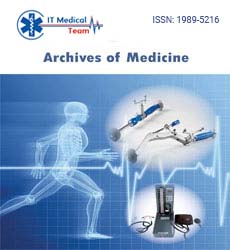Commentary - (2022) Volume 14, Issue 6
Update on hypertrophic cardiomyopathy
Romany He*
Department of Internal Medicine, University of Health Sciences, Antalya, Turkey
*Correspondence:
Romany He, Department of Internal Medicine, University of Health Sciences,
Antalya,
Turkey,
Email:
Received: 25-May-2022, Manuscript No. ipaom-22-12946;
Editor assigned: 28-May-2022, Pre QC No. P-12946;
Reviewed: 17-Jun-2022, QC No. Q-12946;
Revised: 22-Jun-2022, Manuscript No. R-12946;
Published:
30-Jun-2022
Abstract
Hypertrophic Cardiomyopathy (HCM) is a rather common condition
seen by anesthesiologists in the perioperative phase. HCM was
thought to be a rare condition fifty years ago. However, our
understanding and capacity to diagnose HCM patients has vastly
increased in recent years. Patients with HCM have a wide range of
genotypic and phenotypic characteristics. A subset of these patients
does, in fact, have the HCM genotype but not the manifestation (left
ventricular hypertrophy). Pharmacotherapy to control symptoms,
implantable cardiac defibrillators to manage malignant arrhythmias,
and surgical myectomy and septal ablation to reduce the left
ventricular outflow obstruction are all options for these individuals.
For the perioperative care of these patients, an accurate diagnosis
is critical. Left ventricular hypertrophy, left ventricular outflow
tract gradients, systolic and diastolic function, and mitral valve
morphology and function are typically used to make the diagnosis.
Cardiac magnetic resonance imaging can also be used for diagnosis.
Keywords
Cardiomyopathy; Macrolides; COVID-19; Pleiotropic
data.
Introduction
Hypertrophic Cardiomyopathy (HCM) was first
described in 1868, its functional consequences in 1957,
Left Ventricular (LV) asymmetric and especially septal
hypertrophy in 1958, and its familial nature in 1960.
Hypertrophic Cardiomyopathy (HCM) is characterised
by asymmetrical LV thickening without chamber dilation
that occurs in the absence of a known aetiology (e.g. aortic
valvular stenosis [AS], hypertension), and is accompanied
with myocardial fibre disarray:Myocardial cell disarray, in
which cells are arranged in a disordered pattern rather than
in a typical parallel pattern.Coronary microvasculature
failure due to increased wall/ lumen ratio; andremodelling
alterations are the key underlying structural abnormalities
in HCM.These changes can also affect myocytes, fibroblasts,
and the interstitium, and are not restricted to areas of LVH
and myocardial remodelling that occur as a compensatory
mechanism.
These changes take years to manifest before symptoms
appear. Impaired coronary reserve, diastolic dysfunction,
supraventricular and ventricular dysrhythmias, and sudden
death are all symptoms of HCM patients' disorganised
myocyte pattern, increased wall/ lumen ratio of coronaries,
and remodelling alterations.Treatment and outcomes—
medical and surgicalhe existence and amplitude of LVOTO
in HCM patients have been shown to be independent
predictors of sudden death and all-cause cardiac mortality.
Given the mechanisms underlying myocardial
contraction (calcium ions binding to troponin C and
excitation-contraction coupling), as well as the fact that
obstruction in HCM is dynamic and lethal dysrhythmias
are common, a variety of medical regimens have been
used in these patients with the goal of altering the natural
history.Through negative inotropy, the purpose of medical
care with these medications is to reduce or abolish the
LVOT gradient. The majority of medications used to treat
symptomatic HCM patients relieve symptoms by lowering
or eliminating the LVOT pressure gradient. Because
it reduces the dP/dT (change in pressure over time),
-adrenergic blockade can help with dyspnea and angina
symptoms. This, in turn, causes a decrease in LVOTO.
These drugs help reduce LVOTO during exercise
by dampening the sympathetic response, making them
useful for managing symptoms and lowering the risk of
sudden cardiac death. The medications should be titrated
depending on symptom alleviation and an endeavour to
avoid any substantial drug-related side effects. Perhexiline,
a myocyte energy supplement, has recently been proven to
reduce diastolic dysfunction and symptomatology [1-5].
Conclusion
Beyond its antibacterial activities, different antibiotics
elicit pleiotropic effects that have the potential to be of
great benefit in the clinical treatment of viral infection e.g.
COVID-19-induced pneumonia or lung injury preceding
event of secondary infections by bacteria. Impairing
viral entry, interfering with viral replication, attenuating
cytokine storm by reduction of interleukin (IL)-6, IL-
1, tumor necrosis factor (TNF)-α and other combating
oxidative stress; explain the potential efficacy of antibiotics
in the management of severe cases of viral infections More
experimental studies and randomized clinical trials are
needed for investigating their role in reducing mortality
and improving clinical outcomes.
Conflict of Interest
All authors declare that they have no conflict of interest.
Data Availability
All data generated or analyzed during study are included
in this review.
Authors Contribution
RHT, the corresponding author, has the major
contribution in designing, coordinating the duties of each
co-author and edited the final version the manuscript.
SMMBA, searching in literature about macrolides update
pleiotropic activities; HHND, help in designing figures
and searching about beta lactam antibiotics; AZIB, help
in searching about tetracyclines and fluoroquinolones;
MRMT, help in writing manuscript; EMW, help in revising
manuscript linguistically. All authors read and approved
the final manuscript.
Funding
This study was not funded by any specific grant from
funding agencies in the public, commercial, or not-forprofit
sectors.
Acknowledgment
None.
REFERENCES
- Beović B, Doušak M, Ferreira-Coimbra J, et al. Antibiotic use in patients with COVID-19: A ‘snapshot’ Infectious Diseases International Research Initiative (ID-IRI) survey. J Antimicrob Chemother. 2020;75:3386-3390.
Google Scholar, Crossref, Indexed at
- Liu C, Wen Y, Wan W, et al. Clinical characteristics and antibiotics treatment in suspected bacterial infection patients with COVID-19. Int Immunopharmacol. 2021;90:107157.
Google Scholar, Crossref, Indexed at
- Seaton RA, Gibbons CL, Cooper L, et al. Survey of antibiotic and antifungal prescribing in patients with suspected and confirmed COVID-19 in Scottish hospitals. J Infect Chemother. 2020;81:952-960.
Google Scholar, Crossref, Indexed at
- Adebisi YA, Jimoh ND, Ogunkola IO, et al. The use of antibiotics in COVID-19 management: A rapid review of national treatment guidelines in 10 African countries. Trop Medi Health. 2021;49:1-5.
Google Scholar, Crossref, Indexed at
- Jing R, Vunnam RR, Schnaubelt E, et al. Co-infection of COVID-19 and influenza A in a hemodialysis patient: A case report. BMC Infect Dis. 2021; 21:1-6.
Google Scholar, Crossref, Indexed at






